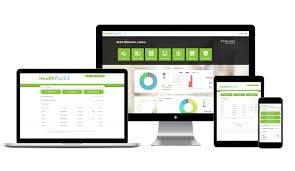Listen to the podcast. Find it on iTunes. Download the transcript. Sponsor: HealthPay24.
Dana Gardner: Hi,
this is Dana Gardner,
Principal Analyst at Interarbor
Solutions, and you’re listening to BriefingsDirect.
 |
| Gardner |
Our next healthcare finance
insights discussion explores new ways of analyzing healthcare revenue trends to
improve both patient billing and services. Stay with us now as we learn about
new approaches to healthcare revenue cycle management and outcomes that give patients
more options and providers more revenue clarity.
To learn more about the next
generation of data-driven patient payments process improvements, we’re now
joined by Jake Intrator,
Managing Consultant for Data and Services at Mastercard. Welcome, Jake.
Jake Intrator: Great
to be here and excited to talk about our joint-solution with HealthPay24.
Gardner: We’re
also here Julie Gerdeman,
CEO of HealthPay24. Welcome back, Julie.
Julie Gerdeman: Thanks so much, Dana.
Gardner:
Julie, what trends or market pressures are driving healthcare providers to seek
new and better ways of analyzing data to better manage patient billing? What’s
wrong with the status quo?
Healthcare’s sea change
Gerdeman: Dana,
we are in such an interesting time, particularly in the US, with this being an
election time. There is such a high level of visibility -- really a spotlight
on healthcare. There is a lot of change happening, such as in regulations, that
highlights interoperability of data and price transparency for patients.
 |
| Gerdeman |
And there’s ongoing change on
the insurance reimbursement side, with payer plans that seem to change and
evolve every year. There are also trends changing provider compensation, including
value-based care and pay-for-performance.
On the consumer-patient side,
there is significant pressure in the market. Statistics show that 62 percent of
patients say knowing their out-of-pocket costs in advance will impact their
likelihood of pursuing care. So the visibility and transparency of costs -- that
price expectation -- is very, very important and is driving consumerism into
healthcare like we have never seen before due to rising costs to patients.
Finally, there is more competition.
Where I live in Pennsylvania, I can drive a five-mile radius and access a
multitude of different health providers in different systems. That level of competition
is unlike anything we have seen before.
Gardner: Jake,
why is healthcare revenue management difficult? Is it different from other
industries? Do they lag in their use of technology? Why is the healthcare industry
in the spotlight, as Julie pointed out?
Intrator: The
word that Julie used that was really meaningful to me was consumerism. There
is a shift across healthcare where patients are responsible for a much larger
proportion of their bills than they ever used to be.
 |
| Intrator |
And so, as things shift away
from hospitals working with payers to receive dollars in an efficient, easy
process -- now the revenue is coming from patients. That means there needs to
be new processes and new solutions to make it a more pleasant experience for
patients to be able to pay. We need to enable people to pay when they want to
pay, in the ways that they want to pay.
That’s something we have keyed
on to, as a payments organization. That’s also what led us to work with
HealthPay24.
Gardner: It’s
fascinating. If we are going to a consumer-type model for healthcare, why not
take advantage of what consumers have been doing with their other financing, such
as getting reports every month on their bills? It seems like there is a great lesson
to be learned from what we all do with our credit cards. Julie, is that what’s
going to happen?
Consumer in driver’s seat
Gerdeman: Yes,
definitely. It’s interesting that healthcare has been sitting in a time warp. Historically,
there remain many manual processes and functions in the health revenue cycle. That’s
attributed to a piecemeal approach -- different segments of the revenue cycle were
tackled either at different times or acquisitions impacted that. I read recently
that there are still eight billion faxes happening in healthcare.
So that consumer-level
experience, as Jake indicated, is where it’s going -- and where we need to go
even faster.
Technology provides the
transparency and interoperability of data. Investment in IT is happening, but
it needs to happen even more.
Gardner:
Wherever there is waste, inefficiency, and a lack of clarity is an opportunity
to fix that for all involved. But what are the stakes? How much waste or mismanagement
are we talking about?
Intrator: The
one statistic that sticks out to me is that care providers aren’t collecting as
much as 80 percent of balances from older bills. So that’s a pretty substantial
amount -- and a large opportunity. Julie, do you have more?
Gerdeman: I
actually have a statistic that’s staggering. There is waste of $265 billion
spent on administrative complexity. And then another $230 to $240
billion attributed to what’s termed pricing failure, which means price
increases that aren’t in line with the current market. The stakes are very high
and the opportunity is very large.
We have data that shows more
than 50 percent of chief financial officers (CFOs) want better access to data and
better dashboards to understand the scope of the problem. As we were talking about
consumerism, Mastercard is just phenomenal in understanding consumer behavior.
Think about the personalized experiences that organizations like Mastercard provide
-- or Google, Amazon, Disney,
and Netflix. Everything is becoming so
personalized in our consumer lives.
But healthcare? We are not
there yet. It’s not a personalized experience where providers know in advance
what a consumer or patient wants. HealthPay24 and Mastercard are coming
together to get us much closer to that. But, truly, it’s a big opportunity.
Intrator: I
agree. Payers and providers haven’t figured out how they enable personalized
experiences. It’s something that patients are starting to expect from the way
they interact with companies like Netflix, Disney, and Mastercard. It’s
becoming table-stakes. It’s really exciting that we are partnering to figure
out how to bring that to healthcare payers and providers alike.
Gardner:
Julie, you mentioned that patients want upfront information about what their
procedures are going to cost. They want to know their obligation before they go
through a medical event. But oftentimes the providers don’t know in advance
what those costs are going to be.
So we have ambiguity. And one
of the things that’s always worked great for ambiguity in other industries is
to look at the data, extrapolate, and get analytics involved. So, how are data-driven
analytics coming to the rescue? How will that help?
Data to the rescue
Gerdeman: Historical
data allows for a forward-looking view. For HealthPay24, for example, we have
been involved in patient payments for 20 years. It makes us a pioneer in the
space. It gives us 20 years of data, information, and trends that we can look
at. To me, data is absolutely critical.
Having come out of the spend management
technology industry I know that in the categories of direct and indirect
materials there have long been well-defined goods and services that are priced and
purchased accordingly.
But, the ambiguity of patient healthcare
payments and patient responsibility presents a new challenge. What artificial intelligence
(AI) and algorithms provide are the capability to help anticipate and predict.
That offers something much more applicable to a patient at a consumer level.
Gardner: Jake,
when you have the data you can use it. Are we still at the point of putting the
data together? Or are we now already able to deliver those AI- and machine learning
(ML)-driven outcomes?
Intrator: Hospitals
still don’t feel like they are making the best use of data. They tie that both
to not having access to the data and not yet having the talent, resources, and
tools to leverage it effectively. This is top of mind for many people in healthcare.
In seeking to help them, there
are two places where I divide the use of analytics. The first is ahead of time.
By using patient estimator tools, can you understand what somebody might owe? That’s
a really tricky question. We are grappling with it at Mastercard.
By working with HealthPay24, we have developed a solution that is ready and working today. Answering the questions gets a lot smarter when you incorporate the data and analytics.
By working with HealthPay24,
we have developed a solution that is ready and working today on the other half
of the process. For example, somebody comes to the hospital. They know that
they have some amount of patient payment responsibility. What’s the right way
for a hospital to interact with that person? What are the payment options that
should be available to them? Are they paying upfront? Are they paying over a
period of time? What channels are you using to communicate? What options are
you giving to them? Answering those questions gets a lot smarter when you
incorporate data and analytics. And that’s exactly what we are doing today.
Gardner: Well,
we have been dancing around and alluding to the joint-solution. Let’s learn
more about what’s going on between HealthPay24 and Mastercard. Tell us about
your approach. Are we in a proof of concept (POC) or is this generally available?
Win-win for patients and providers
Gerdeman: We
are currently in a POC phase, working with initial customers on the predictive
analytic capability that marries the Mastercard Test
and Learn platform with HealthPay24’s
platform and executing what’s recommended through the analytics in our
platform.
Jake, go ahead and give an
overview of Test and Learn, and then we can talk about how we have come
together to do some great work for our customers.
Intrator: Sure.
Test and Learn is a platform that Mastercard uses with a large number of
partner clients to measure the impact of business decisions. We approach that through
in-market experiments. You can do it in a retail context where you are changing
prices or you can do it in the healthcare context where you are trying
different initiatives to focus on patient payments.
That’s how we brought it to
bear within the HealthPay24 context. We are working together along with their
provider partners to understand the tactics that they are using to drive
payments. What’s working, what’s working for the right patient, and what’s
working at the right time for the right patients?
Gerdeman: It’s
important for the audience to understand that the end-goal is revenue
collection and the big opportunity providers have to collect more. The marriage
of Test and Learn with HealthPay24 provides the intelligence to allow providers
to collect more, but it also offers more options to patients based on that
intelligence and creates a better patient experience in the end.
The marriage of Test and Learn with HealthPay24 provides the intelligence to allow providers to collect more, but it also offers more options to patients based on that intelligence, and creates a better patient experience.
If a particular patient will always
take a payment plan and make those payments consistently – that is versus when
they are presented with a big amount and wouldn’t pay it off – the intelligence
through the platform will say, “This patient should be offered a payment plan
consistently,” and the provider ends up collecting all of the revenue.
That’s what we are super-excited
about. The POC is showing greater revenue collection by offering flexibility in
the options that patients truly want and need.
Gardner: Let’s
unpack this a little bit. So we have HealthPay24 as chocolate and Mastercard’s
Test and Learn platform as peanut butter, and we are putting them together to
make a whole greater than the sum of the parts. What’s the chocolate? What’s
the peanut butter? And what’s the greater whole?
Like peanut butter and chocolate
Intrator: One of
the things that’s made working with HealthPay24 so exciting for us is that they
sit in the center of all of the data and the payment flows. They have the capability
to directly guide the patient to the best possible experience.
They are hands-on with the
patients. They can implement all of these great learnings through our analytics.
We can’t do that on our own. We can do the analytics, but we are not the infrastructure
that enables what’s happening in the real world.
That’s HealthPay24. They are in
the real world. When you have the data flowing back and forth, we can help
measure what’s working and come up with new ideas and hypotheses about how to
try different payment programs.
It’s been a really important
chocolate and peanut butter combination where you have HealthPay24 interacting
with patients and us providing the analytics in the background to inform how that’s
happening.
Gerdeman: Jake
said it really well. It is a beautiful combination because years ago, the hot
thing was propensity to pay. And, yes, providers still talk about that. It was
best practice many years ago, of pulling a soft or even hard credit check on a
patient to determine their propensity to pay and potentially offer financial
assistance, even charity, given the needs of the patient.
But this takes it to a whole
other level. That’s why the combination is magical. What makes it so different is
there doesn’t need to be that old way of thinking. It’s truly proactive through
the data we have in working with providers and the unique capabilities of
Mastercard Test and Learn. We bring those together and offer proactively the
right option for that specific patient-consumer.
It’s super exciting because
payment plans are just one example. The platform is phenomenal and the
capabilities are broad. The next financial application is discounts.
Through HealthPay24, providers
could configure discounts based on their own policies and thresholds. But, if
you know that a particular patient will pay the amount when offered the
discount through the platform, that should be offered every time. The
intelligence gives us the capability to know that, to offer it, and for the
provider to collect that discounted amount, which might be more than that
amount going to bad debt and never being collected.
Intrator: If
you are able to drive behavior with those discounts, is it 10 percent or 20
percent? If you give away an additional 10 percent, how does that change the
number of people reacting to it? If you give away more, you had better hope
that you are getting more people to pay more quickly.
Those are exactly the sorts of analytical questions we can answer with Test and Learn and with HealthPay24 leading the charge on implementing those solutions. I am really excited to see how this continues to solve more problems going forward.
Gardner: It’s
interesting because in the state of healthcare now, more and more people, at
least in the United States, have larger bills regardless of their coverage. There
are more co-pays, more often there are large deductibles, with different deductibles
for each member of a family, for example, and varying deductibles depending on
the type of procedures. So, it seems like many more people will be facing more
out-of-pocket items when it comes to healthcare. This impacts literally tens of
millions of people.
So we have created this new chocolate
confection, which is wonderful, but the proof is in the eating. When are patient-consumers
going to get more options, not only for discounts, but perhaps for financing? If
you would like to spread the payments out, does it work in both ways, both
discounts as well as in payment plans with interest over time?
Flexibility plus privacy
Gerdeman: In
HealthPay24, we currently have all of the above -- depending on what the
provider wants to offer, their patient base, and the needs and demographics. Yes,
they can offer payment plans, discounts, and lines of credit. That’s already
embedded in the platform. It creates an opportunity for all the different
options and the flexibility we talked about.
Earlier I mentioned
personalization, and this gets us much closer to personalization of the
financial experience in healthcare. There is so much happening on the clinical
side, with great advances around clinical care and how to personalize it. This
combination gets us to the personalization of offers and options for patients and
payments like we have never seen in the past.
Gardner: Jake,
for those listening and reading, who maybe are starting to feel a little concerned
that all this information -- about not just their healthcare, but now their
finances -- being bandied about among payers, providers, and insurers, are we
going to protect that financial information? How should people feel about this
in terms of a privacy or a comfort level?
We aspire and really do put a lot of work and effort into being a leader in data privacy and allowing people to have ownership of their data and to feel comfortable.
Intrator: That
is a question and a problem near and dear to Mastercard. We aspire and really do
put a lot of work and effort into being a leader in data privacy and allowing
people to have ownership of their data and to feel comfortable. I think that’s
something that we deeply believe in. It’s been a focus throughout our
conversations with HealthPay24 to make sure that we are doing it right on both
sides.
Gardner: Now
that you have this POC in progress, what have been some of the outcomes? It
seems to me over time the more you deal with more data, the more benefits, and
then the more people adopt it, and so on. Where are we now, and do we have some
insight into how powerful is this?
Gerdeman: We do.
In fact, one example is a 400-bed hospital in the Northeast US that, through
the combination of Mastercard Test and Learn and HealthPay24, were able to look
at and identify 25,000 unpaid accounts. Just by targeting 5,000 of the 25,000,
they were able to identify an incremental $1 million in collections to the
hospital.
That is very significant in
that they are just targeting the top 5,000 in a conservative approach. They now
know that they have the capability through this intelligence and by offering
the right plans to the right people to be able to collect $1 million more to
their bottom line.
Intrator: That certainly
captures the big picture and the big story. I can also zoom in on a couple of
specific numbers that we saw in the POC. As we tackled that, we wanted to
understand a couple of different metrics, such as increases in payments. We saw
substantial increases from payment plans. As a result, people are paying more than
60 percent more on their bills compared to similar patients that haven’t received
the payment plans.
Then we zoomed in a step
farther. We wanted to understand the specific types of patients who benefited
more from receiving a payment plan and how that potentially could guide us
going forward. We were able to dig in, to build a predictive model, and that’s
exactly what Julie was talking about. Those top 25,000 accounts, how much we
think they are going to pay and the relative prioritization. Hospitals have
limited resources. So how do you make sure that you are focusing most
appropriately?
Gardner: Now
that we have gotten through this trial period, does this scale? Is this
something you can apply to almost any provider organization? If I am a provider
organization, how might I start to take advantage of this? How does this go to
market?
Personalized patient experiences
Gerdeman: It
absolutely does scale. It applies across all providers; actually, it applies
across many industries as well. Any provider who wants to collect more wants
additional intelligence around their patient behavior, patient payments and
collection behavior -- it really is a terrific solution. And it scales as we
integrate the technologies. I am a huge believer in best-of-breed ecosystems. This
technology integrates into the HealthPay24 solution. The recommendations are
intelligent and already in the platform for providers.
Gardner: And
how about that grassroots demand? Should people start going into their clinics
and emergency departments and say, “Hey, I want the plan that I heard about. I
want to have financing. I want you to give me all my options.” Should people be
advocating for that level of consumerism now when they go into a healthcare
environment?
Gerdeman: You
know, Dana, they already are. We are at a tipping point in the disruption of
healthcare. This kind of grassroots demand of consumerism and a consumer
personalized experience -- it’s only a matter of time. You mentioned data
privacy earlier. There is a very interesting debate happening in healthcare
around the balance between sharing data, which is so important for care, billing,
and payment, with the protection of privacy. We take all of that very
seriously.
Nonetheless, I feel the demand
from providers as well as patients will only get greater.
Gardner:
Before we close out let’s extrapolate on the data we have. How will things be
different in two or three years from now when more organizations embrace these
processes and platforms?
Intrator: The
industry is going to be a lot smarter in a couple of years. The more we learn
from these analytics, the more we incorporate it into the decisions that are
happening every day, then it’s going to feel like it fits you as a patient
better. It’s going to improve the patient experience substantially.
The industry is going to be a lot smarter in a couple of years. The more we learn from these analytics, the more we incorporate it into the decisions that are happening every day. It's going to improve the patient experience substantially.
Personally, I am really
excited to see where it goes. There are going to be new solutions that we haven’t
heard about yet. I am closely following everything that goes on.
Gerdeman: This
is heading to an experience for patients where from the moment they seek care,
they research care, they are known. They are presented with a curated,
personalized experience from the clinical aspect of their encounter all the way
through the billing and payment. They will be presented with recommendations
based on who they are, what they need, and what their expectations are.
That’s the excitement around
AI and ML and how it’s going to be leveraged in the future. I am with Jake. It’s
going to look very different in healthcare experiences for consumers over the
next few years.
Gardner: And
for those interested in learning more about this pilot program, about the
Mastercard Test and Learn platform and HealthPay24’s platform, where might they
go? Are there any press releases, white papers? What sort of information is
available?
Gerdeman: We
have a great case study from the POC that we are currently running. We are
happy to work with anyone who is interested, just contact us via our website at
HealthPay24 or through Mastercard.
Gardner: I’m
afraid we will have to leave it there. You have been listening to a sponsored
BriefingsDirect healthcare finance insights discussion on new ways of analyzing
healthcare revenue trends to both improve patient billing and services.
And we have learned about new
approaches to healthcare revenue cycle management and the outcomes that give
patients more options and providers more revenue clarity. So please join me in
thanking our guests, Jake Intrator, Managing Consultant for Data and Services
at Mastercard. Thank you so much, Jake.
Intrator: Thank
you.
Gardner: And
thank you as well to Julie Gerdeman, CEO of HealthPay24. Always a pleasure,
Julie.
Gerdeman:
Thanks so much, Dana.
Gardner: And a big thank you to our audience as well for joining this HealthPay24-sponsored healthcare thought leadership discussion. I’m Dana Gardner, Principal Analyst at Interarbor Solutions, your host and moderator. Thanks again for listening and do come back next time.
Listen to the podcast. Find it on iTunes. Download the transcript. Sponsor: HealthPay24.
Transcript
of a discussion on new approaches to healthcare
revenue cycle management and outcomes that give patients more options and
providers more revenue clarity. Copyright Interarbor Solutions, LLC, 2005-2020.
All rights reserved.
You may also be
interested in:
- Delivering a new breed of patient access best practices requires an alignment of people, process, and technology
- Healthcare providers define new ways to elevate and improve the digital patient experience
- As price transparency grows inevitable, healthcare providers need better tools to close the gap on patient trust
- Cerner’s lifesaving sepsis control solution shows the potential of bringing more AI-enabled IoT to the healthcare edge
- How healthcare providers are taking cues from consumer expectations to improve patient experiences
- Data-driven and intelligent healthcare processes improve patient outcomes while making the IT increasingly invisible
- Price transparency in healthcare to regain patient trust requires accuracy via better use of technology
- How enterprises like McKesson digitize procurement and automate spend management to slash waste
- How The Open Group Healthcare Forum and Health Enterprise Reference Architecture cures process and IT ills













